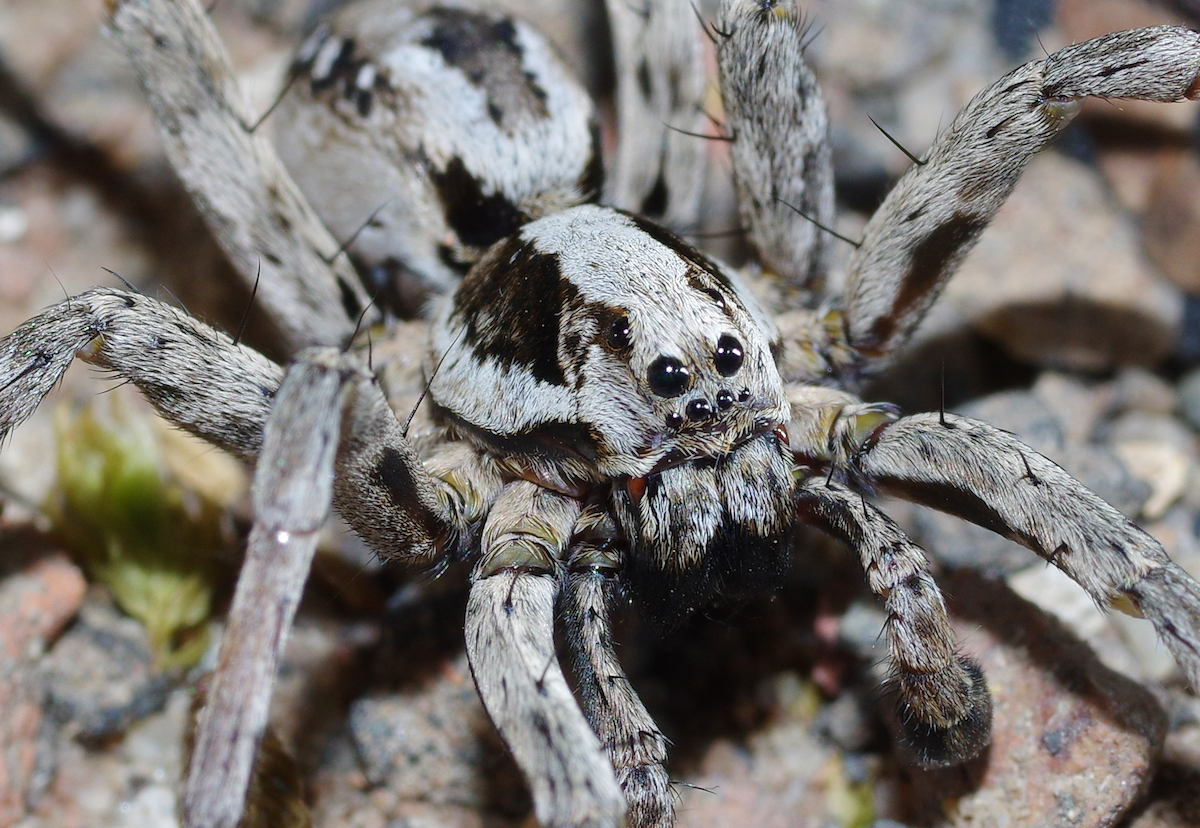 Abraham Lincoln
If given the truth, the people can be depended upon to meet any national crisis...
Abraham Lincoln
If given the truth, the people can be depended upon to meet any national crisis...
 Guildford news...
for Guildford people, brought to you by Guildford reporters - Guildford's own news service
Guildford news...
for Guildford people, brought to you by Guildford reporters - Guildford's own news service
Giant Hunting Spiders Once Feared Extinct Discovered on Surrey MoD Site
Published on: 31 Oct, 2020
Updated on: 3 Nov, 2020
After more than 25 years without a sighting, some of Britain’s largest and most endangered spiders have been rediscovered on a Ministry of Defence (MoD) training area in Surrey.
Surrey Wildlife Trust had the great fox-spider red-listed as “Critically Endangered” and feared extinct in the UK. They had been found at only three sites, two in Dorset and the other in Surrey, but hadn’t been seen since the early 1990s. Surrey Wildlife would not say where in the county the army training area is located.
Great fox-spiders do not spin webs to trap prey, nor will you ever find them lurking in your shower. They are ground-dwelling and largely nocturnal, but Mike Waite, spider enthusiast at the Trust, had never given up hope of finding the monsters, spending many night hours searching with a torch over the past two years.
Finally, he discovered some unidentifiable immature spiderlings, on MoD land managed by the Amphibian and Reptile Conservation Trust, then at last, several mature males and one female great fox-spider, which was 55mm or just more than two inches in diameter, including its hairy, spiny legs.
With excellent eyesight, camouflage and speed, the great fox-spider Alopecosa fabrilis is among the largest of the wolf-spider Lycosidae family of spiders. An opportunistic predator which hunts at night it is named for its wolf-like habit of chasing down its prey, across sandy terrain, over gravel and rocks before pouncing and capturing insects on the run.
Not only incredibly agile and fast-running, great fox-spiders have excellent eyesight with wrap-around vision provided by eight black eyes on its head, or cephalothorax. Two large eyes glint from the top of the head; two large eyes stare out the front; and four smaller eyes form a row just above the spider’s mouth.
Great Fox-Spiders immobilise their prey, including insects such as beetles, ants and smaller spiders, by injecting them with venom, which liquifies the insect’s internal organs. The spider feasts on its catch using its strong, fang-bearing front appendages called chelicerae.
For shelter, the great fox-spiders dig burrows or holes under rocks and logs and make a silk-lined burrow as a retreat for the winter. Mr Waite now plans to continue his study to gauge the size of the population.
“The Great Fox-Spider has not been seen since 1993,” he said. “The spider is at the very edge of its range in the UK, which accounts for its super-rarity here.
“This formidable-looking creature is an impressive beast, perfectly camouflaged and also largely nocturnal, and for all its size it has been remarkably elusive.
“Naturally, I am over-the-moon to have finally proved the continued existence of the great fox-spider in the UK. Although I’ve always held a latent interest in spiders, as a bona-fide arachnologist, I am still a relative newbie, so I’m doubly pleased to have made this important contribution to our scientific knowledge.”
Naturalist Nick Baker, TV presenter and president of the British Arachnological Society, said: “The prefix ‘great’ doesn’t seem to do it justice, maybe it should be the fabulous, or fantastic fox-spider. Even if the back story of its rarity and its rediscovery wasn’t taken into count, this spider is mega.
“It’s about as handsome as a spider gets, it’s big and now it’s officially a member of the British fauna again. The rediscovery of the great fox-spider is indeed the most exciting thing to happen in wildlife circles for quite some time. Glad it’s in safe hands.”
The MoD’s Rich Lowey said: “Many people are unaware of the size and diversity of the Defence estate and its tremendous wildlife richness.
“It has generally been protected from agricultural intensification and urban development, so it now provides a vital sanctuary for many of the country’s most rare and endangered species and habitats.
 “We are proud to hear the great fox-spider has survived because of the MoD’s commitment and enthusiasm to have positive and active conservation management on the Estate and close integrated working with ARC, Surrey Wildlife Trust and MOD Conservation Groups.”
“We are proud to hear the great fox-spider has survived because of the MoD’s commitment and enthusiasm to have positive and active conservation management on the Estate and close integrated working with ARC, Surrey Wildlife Trust and MOD Conservation Groups.”
Rob Free, Weald Reserves manager, Amphibian and Reptile Conservation (ARC), said: “The discovery of the great fox-spider shows how amazing the MoD heathland is, not just for spiders, but also for sand lizard, smooth snake, Dartford warbler, nightjar, silver-studded blue butterfly and marsh clubmoss.
“The spider’s rediscovery is a wonderful exoneration of all the incredibly hard work put in by MoD staff, conservation group members, ARC staff and volunteers.”
ARC has managed key parts of the site since 1974, with particular emphasis on preventing the endangered sand lizard from extinction, and as the MoD’s conservation partner, ARC has been managing much of the open heathland on the site since January 2019.
The MoD site is recognised as being nationally important for its populations of rare bird, reptile and invertebrate species.
For further information or to support Surrey Wildlife Trust visit www.surreywildlifetrust.org
Responses to Giant Hunting Spiders Once Feared Extinct Discovered on Surrey MoD Site
Leave a Comment Cancel replyPlease see our comments policy. All comments are moderated and may take time to appear.

See Dragon story: GBC’s Explanation of Major Land Sale Notice Error ‘Borders on Arrogant’ Says Councillor






Recent Articles
- Guide to Telephone Befriending Services for Older People
- Stage Dragon: Sleuth at the Yvonne Arnaud Theatre
- Guildford Lido All Set for the 2024 Season
- Appointment of Permanent Joint Strategic Director of Finance Confirmed
- Police and Crime Commissioner Candidate Interview – Alex Coley
- New Approach to Mental Health Concerns Reported to the Police
- Letter: Bernard Quoroll ‘s Insight Should Be Heard
- Police and Crime Commissioner Candidate Interview – Paul Kennedy
- Staff Union Warns Surrey University of No Confidence Votes
- Invitation to Join Mass Bike Ride on Saturday, April 27


Recent Comments
- Bibhas Neogi on M25 Junction 10 Project Required Major Engineering to Overcome Pipeline Snag
- Roland Dunster on Birdwatcher’s Diary No.302
- J Davies on Insights Part 3: The Council Should Not Be Marking Its Own Homework
- Angela Richardson on Insights Part 3: The Council Should Not Be Marking Its Own Homework
- Peter Wilkinson on Anger Over Traffic Impact of Golf Club Scheme
- Nicola King on Anger Over Traffic Impact of Golf Club Scheme
Search in Site
Media Gallery
Dragon Interview: Local Artist Leaves Her Mark At One of England’s Most Historic Buildings
January 21, 2023 / No Comment / Read MoreDragon Interview: Lib Dem Planning Chair: ‘Current Policy Doesn’t Work for Local People’
January 19, 2023 / No Comment / Read MoreA3 Tunnel in Guildford ‘Necessary’ for New Homes, Says Guildford’s MP
January 10, 2023 / No Comment / Read More‘Madness’ for London Road Scheme to Go Ahead Against ‘Huge Opposition’, Says SCC Leader
January 6, 2023 / No Comment / Read MoreCouncillor’s Son Starts Campaign for More Consultation on North Street Plan
December 30, 2022 / No Comment / Read MoreCounty Council Climbs Down Over London Road Works – Further ‘Engagement’ Period Announced
December 14, 2022 / No Comment / Read MoreDragon Interview: GBC Reaction to the Government’s Expected Decision to Relax Housing Targets
December 7, 2022 / No Comment / Read MoreHow Can Our Town Centre Businesses Recover? Watch the Shop Front Debate
May 18, 2020 / No Comment / Read More










Harry Eve
November 1, 2020 at 9:07 pm
What a find!
It is great to have such uplifting news in the midst of the destruction currently planned for our local countryside.